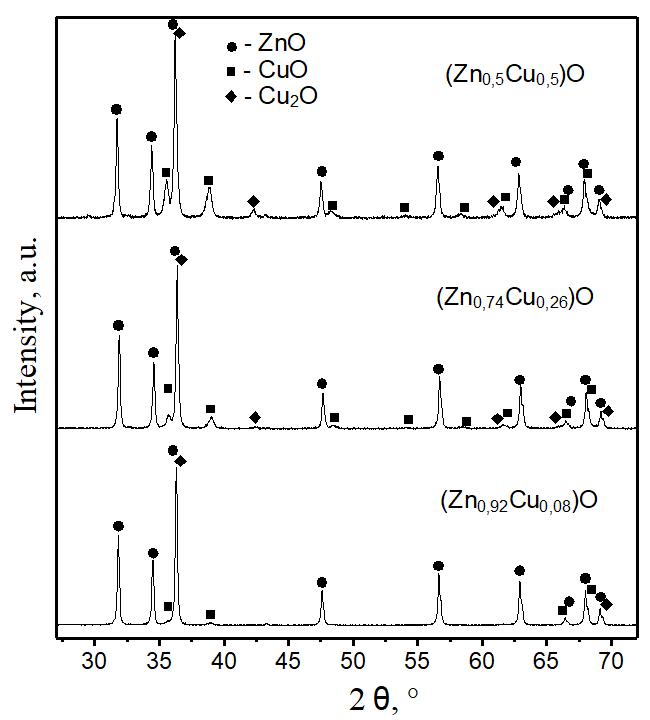Bimetallic nanoparticle W-Cu
Description
The content of components is regulated from 20 wt% to 70 wt% W the rest is Cu. Most tungsten and copper nanoparticles are homogeneously mixed together. Also, a small amount of nanoparticles with a core-shell structure is found in the powder (a layer of copper is located on the surface of the tungsten core) and Janus nanoparticles. The average nanoparticle size is about 80 nm. X-ray diffraction data showed that the presence of α and β phases of tungsten and Cu is characteristic of all the samples obtained. Compounds of tungsten with nitrogen according to X-ray diffraction data were not found. The lattice parameters are close to the standard values for Cu and W.
Particle Photo
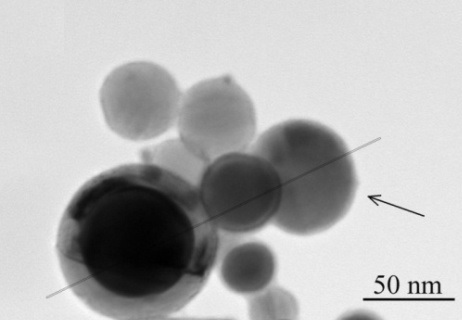
The distribution of components nanoparticles (EDS analysis data) components
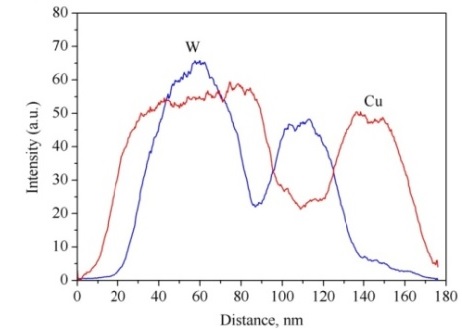
Bimetallic nanoparticle Fe-Cu
Description
The content of components is regulated from 30 wt% to 70 wt% Fe the rest is Cu. Nanoparticles are represented by two structures - the core-shell and Janus nanoparticles. Particles with a core-shell structure have an iron core and a copper shell. The average probabilistic nanoparticle size is about 70 nm. X-ray diffraction data show that the presence of the α phase of Fe and Cu is characteristic of all the samples obtained. The parameters of the crystal lattices are close to the standard values for Fe and Cu.
Particle Photo
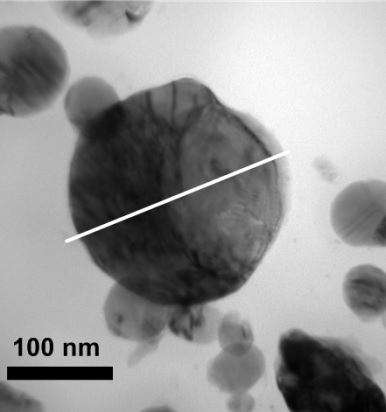
The distribution of components nanoparticles (EDS analysis data) components
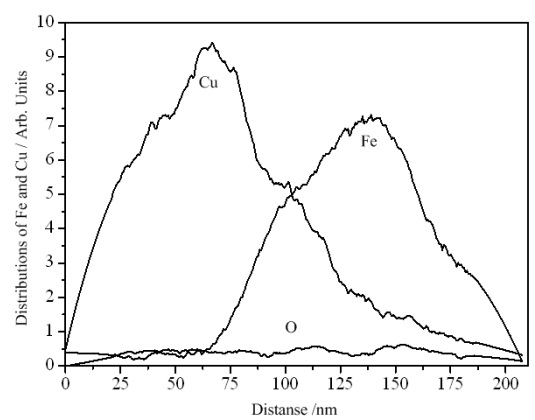
Bimetallic nanoparticle Nb-Cu
Description
The content of components is regulated from 30 wt% to 70 wt% Cu the rest is Nb. The predominant formation of nanoparticles with the structure of the Janus particles is characteristic. The average probability size of nanoparticles is 70-80 nm. X-ray diffraction data showed that for all the samples obtained, the lattice parameters are close to standard values.
Particle Photo
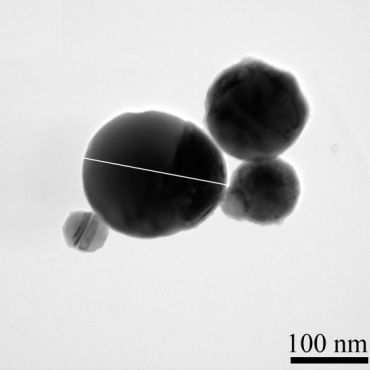
The distribution of components nanoparticles (EDS analysis data) components
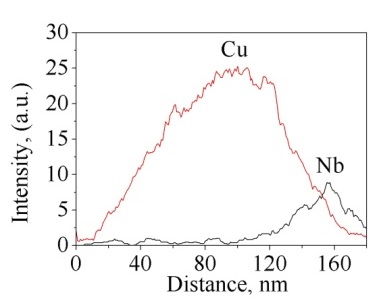
Bimetallic nanoparticle Ni-Ag
Description
The content of components is regulated from 30 wt% to 70 wt Ni the rest of Ag. The formation of nanoparticles with the structure of the Janus particles and the core - shell is characteristic. The average probabilistic nanoparticle size is about 70 nm. X-ray diffraction data showed that the presence of the Ni and Ag phases is characteristic of all the samples obtained. The parameters of the crystal lattices are close to standard values.
Particle Photo
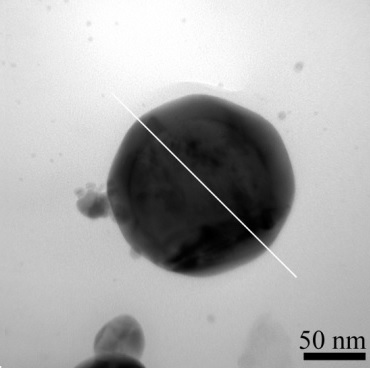
The distribution of components nanoparticles (EDS analysis data) components
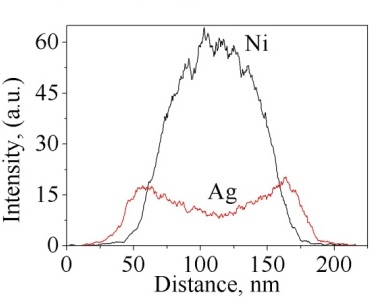
Bimetallic nanoparticle Fe-Pb
Description
The content of components is regulated from 30 wt% to 70 wt% Fe the rest is Pb. A characteristic structure for Fe-Pb nanoparticles are Janus particles. The average probabilistic nanoparticle size is about 80 nm. X-ray diffraction data showed that all the samples obtained are characterized by the presence of α, β phases of lead oxide, as well as the α phases of Fe and Pb. The crystal lattice parameters of the α phase of Fe and Pb are close to standard values.
Particle Photo
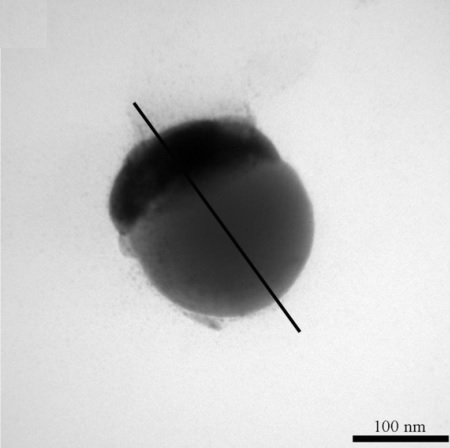
The distribution of components nanoparticles (EDS analysis data) components
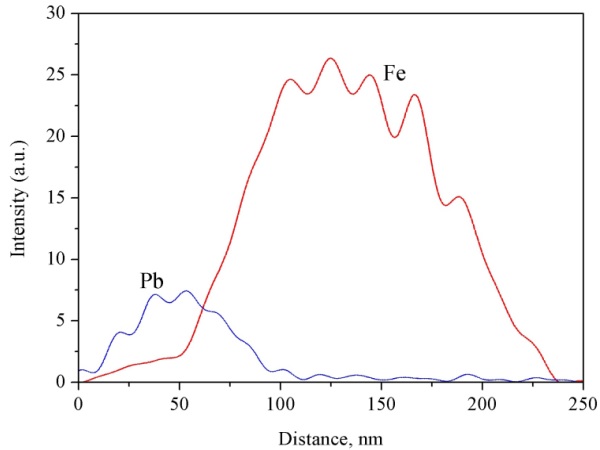
Bimetallic nanoparticle Fe-Ag
Description
The content of components is regulated from 20 wt% to 80 wt% Fe the rest is Ag. The characteristic structures for Fe-Ag nanoparticles are the Janus particles and the core-shell. The average probabilistic nanoparticle size is about 80 nm. X-ray diffraction data showed that the presence of the α phase of Fe and Ag is characteristic of all the samples obtained. The crystal lattice parameters of the α phase of Fe and Pb are close to standard values.
Particle Photo
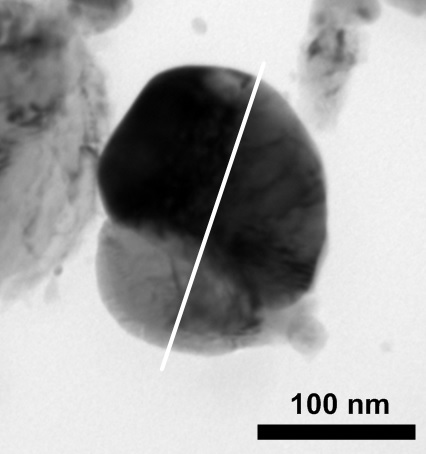
The distribution of components nanoparticles (EDS analysis data) components
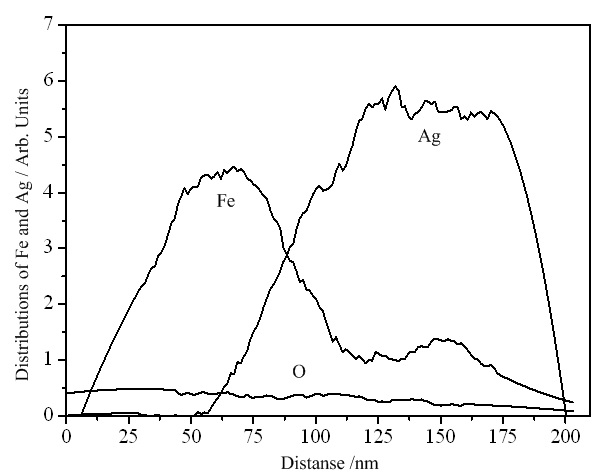
Bimetallic nanoparticle Al-Pb
Description
The content of the components is 30 wt% Al, the rest is Pb. The characteristic structure for Al-Pb nanoparticles are Janus particles. The average nanoparticle size is 96 nm. The XRD data of Al-Pb nanoparticles indicate the presence of crystalline phases of aluminum (2θ ≈ 45 ° and 2θ ≈ 66 °) and lead (peaks 2θ ≈ 36 °, 2θ ≈ 53 ° and 2θ ≈ 62 °)
Particle Photo
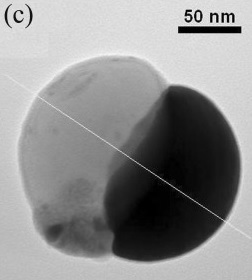
The distribution of components nanoparticles (EDS analysis data) components
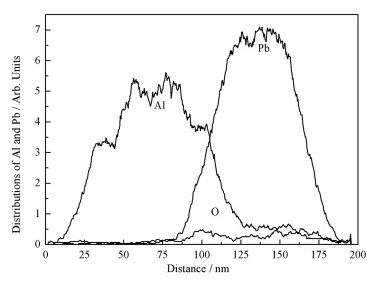
Bicomponent metal oxide nanoparticle TiO2-ZnO
Particle Photo
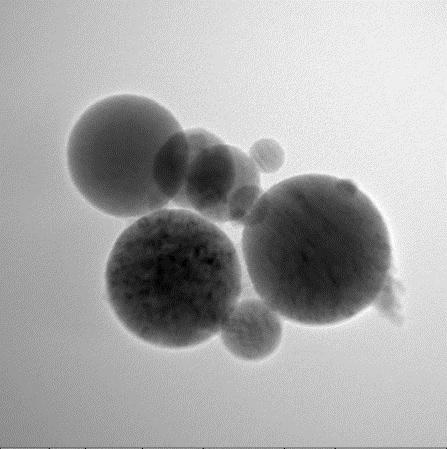
Bimetallic nanoparticle Al2O3-Ag
Description
At a low silver content (15 at.% See Fig.) in dispersible wires, it mainly precipitates on the surface of Al2O3 nanoparticles in the form of individual particles up to 10 nm in size. With an increase in silver content to 33 at.% in dispersible wires, the proportion of large silver particles increases, while the proportion of small silver clusters covering the particles decreases. An increase in silver in dispersible wires to 67 at.% also leads to the formation of larger silver particles. According to x-ray phase analysis, the main reflections of the samples in the diffraction patterns correspond to the ϭ-Al2O3 and Ag phases. The ratio of the integrated intensities of reflexes corresponds to the ratio of dispersed metals.
Particle Photo
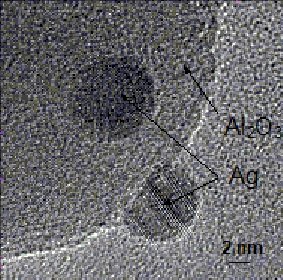
The distribution of components nanoparticles (EDS analysis data) components
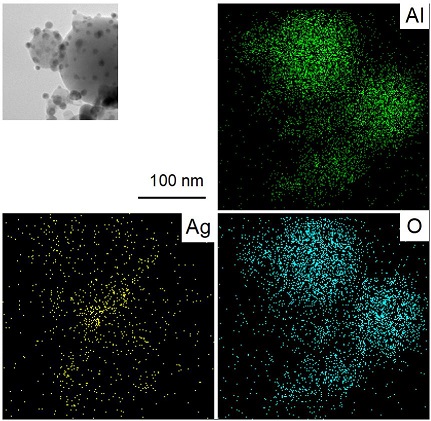
Bimetallic nanoparticle CuO-Ag
Description
In an electric explosion of Cu and Ag wires in an oxygen-containing atmosphere, composite nanoparticles of the composition (Cu0.85Ag0.15) O, (Cu0.48Ag0.52) O and (Cu0.1Ag0.9) O were obtained. According to transmission electron microscopy, a sample of (Cu0.85Ag0.15) O is predominantly represented by spherical particles. According to elemental analysis, particles having a block structure contain both copper and silver atoms, while the sample also contains particles that do not have a clear phase separation, which are enriched in copper compounds. The (Cu0.48Ag0.52) O sample (Fig.) is characterized by the presence of round-shaped particles, and according to elemental analysis, the particles have a clear interface between copper and silver phases and have a janus particle structure. Sample (Cu0.1Ag0.9) O is represented by a set of rounded particles about 100 nm in size and smaller particles with a size of 10-30 nm. According to elemental analysis, copper compounds are not evenly distributed over the particles and concentrated in the form of islands on the surface of silver-containing particles.
Particle Photo
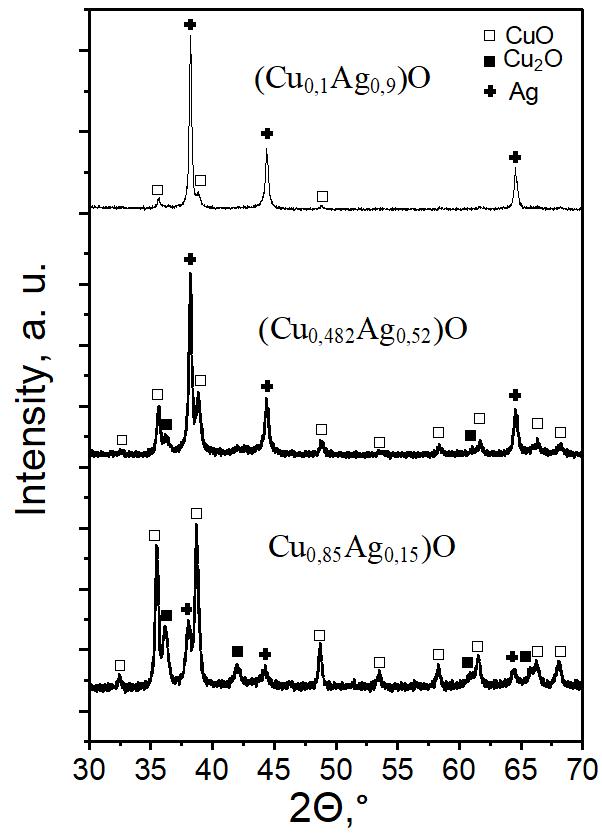
The distribution of components nanoparticles (EDS analysis data) components
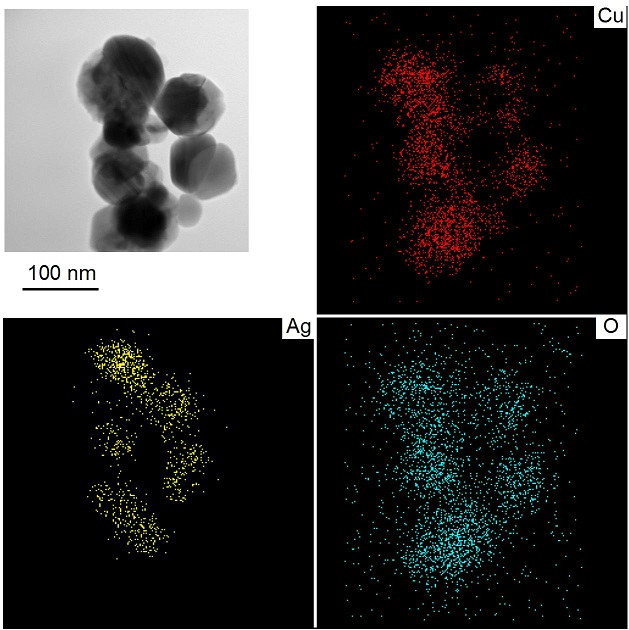
Bimetallic nanoparticle ZnO-Ag
Description
In an electric explosion of Zn and Ag wires in an oxygen-containing atmosphere, composite nanoparticles of the composition (Zn0.88Ag0.12) O, (Zn0.72Ag0.28) O and (Zn0.55Ag0.45) O- were obtained (Fig.). According to transmission electron microscopy, the particles of all samples have different shapes and sizes. Elemental analysis in the mapping mode indicates that Zn and Ag are not evenly distributed. Samples are a mixture of particles enriched in zinc and particles enriched in silver.
Particle Photo
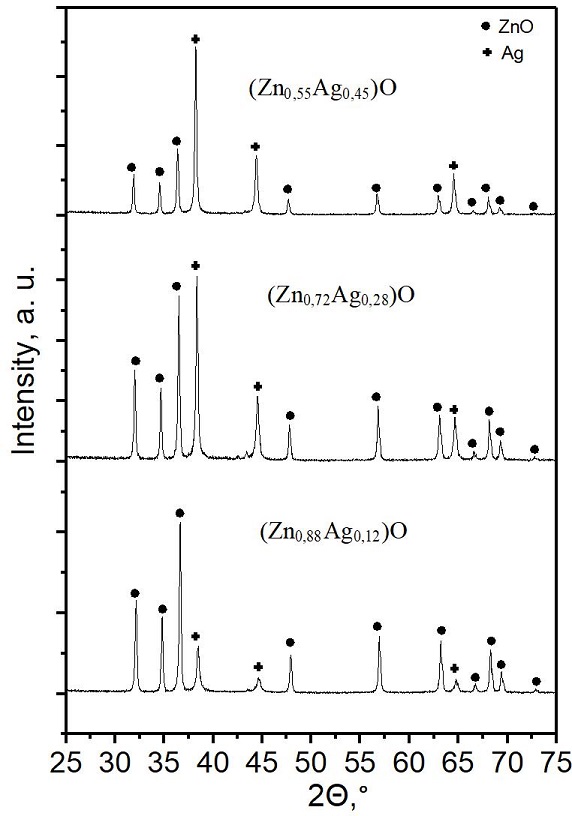
Bimetallic nanoparticle CuO-ZnO
Description
As a result of the electric explosion of Cu and Zn wires in an oxygen-containing atmosphere, composite nanoparticles of the composition (Zn0.5Cu0.5) O (Fig.), (Zn0.74Cu0.26) O and (Zn0.92Cu0.08) O were obtained. It was found that (Zn0.5Cu0.5) O particles are predominantly spherical or close to spherical in shape. According to elemental analysis, in some nanoparticles, Cu and Zn are evenly distributed, some are characterized by a predominance in one of the elements, and particles with separated components in the form of a core-shell structure or a janus particle are also found.
Particle Photo
